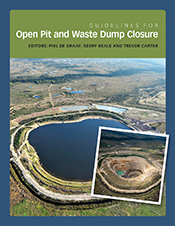Principal Objective: To provide practical open pit mine closure guidelines for use by geotechnical and hydrogeological mining professionals addressing technical issues, design criteria, and reliability and realistic risks to end land users, outlined in a transparent and consistent manner. The book is aimed at all stakeholders, including regulators and the community, who must have benchmarks by which to judge whether adequate closure studies and investigations have been completed to support and justify mining project approval, and ultimate mine closure.

Phil de Graaf
Geoff Beale
Trevor Carter
Editors: Phil de Graaf, Geoff Beale & Trevor Carter
Working Committee: Phil de Graaf, Geoff Beale, Trevor Carter, Justin Dixon, & Pete Stacey
Chapter Leads: Derek Chubb, Carl Grant, Darren Murphy, Bjorn Weeks, Mark Hawley, Daniel Limpitlaw, Mark Williams
Closure planning is a fundamental requirement of all existing and planned future mines. The program for open pit closure must consider the requirements of internal and external stakeholders, local regulatory requirements, global experience, leading practice and continuous improvement. Maintaining a social license to operate increasingly presents a risk to the mining industry, with shifting expectations of investors, insurers, community stakeholders and regulators. These include demands for significant reductions in environmental and social impacts from mining activities. Large open pits are often clearly visible to local communities, and to anyone with access to Google Earth, as are large waste rock dumps and tailings storage facilities. These features present significant challenges due to:
- The need for integration of multi-disciplinary factors to successfully scope, design, execute and monitor a closure plan over periods sometimes spanning significant time. This process must take into account practical considerations.
- The frequent requirement for initial closure plans to be formulated when only limited preliminary information is available.
- Significant risk to personnel in the mine area, the environment, adjacent populations and infrastructure if unexpected adverse closure issues are unmitigated.
- Regulators becoming increasingly risk averse and reluctant to issue full relinquishment closure certificates.
- Substantial costs associated with implementation of closure plans, and the potential for open-ended liability if active management is required in perpetuity.
Current Challenges:
- Strategic planning for closure during early stages of project development when only limited information is available. Closure planning needs to start “big-picture” and work downward, alongside strategic and tactical planning that considers existing global experience (the “lessons learned”).
- Integration of multi-disciplinary factors to scope, design, execute and monitor a closure plan over project stages that may span many decades. Detailed studies often do not consider site-specific conditions, the needs of the operation or the strategic closure objectives.
- Impractical plans with unrealistic expectations, developed by Corporate staff and/ or consultants that often do not consider site-specific conditions, the needs of the operation or the integration of closure objectives.
- Identification of the real risks and the need to provide flexibility to implement the required mitigation when conditions change. Closure should be approached like operations, with a need to accommodate changing conditions that dictate an observational approach (implement, monitor, adjust, mitigate).
- Budgeting associated with closure planning and implementation; avoiding open-ended liability for active management in perpetuity.
The preparation and approval of plans does not provide sufficient flexibility to implement the required mitigation when conditions change. Closure planning has similar constraints as operations, with both having to accommodate changing conditions. A big-picture approach to closure combined with the observational method has the best potential to succeed, (monitor, adjust, mitigate). Too much detail is often required in “early-stage” closure plans that, when approved, become committed, and are subsequently found to be inappropriate as more site-specific detail becomes available during operations.
Several high-level closure guideline documents exist that outline general motherhood objectives for closure, such as: “demonstrated safe, stable, will not cause environmental harm and is able to sustain post-mining land use”, but little guidance is given on how to achieve these aims. Some of these objectives clearly require significant geotechnical and hydrogeological input (to quantify levels of safety and stability). However, details on appropriate design acceptance criteria (i.e., what defines acceptably as ‘safe’ and ‘stable’), input data confidence, analysis approaches, and long-term monitoring guidelines are poorly defined and in consequence are often either not applied appropriately or ignored.
This new Guideline focuses on the need for clarity on geotechnical and hydrogeological guidelines relating to closure planning, definition of pragmatic objectives and measures of success, implementation and monitoring for open pits and waste dumps for closure, and how these interact with adjacent land uses. The Guidelines will define a state-of-best-practice pathway for closure of pits and dumps that reflects industry-wide experience and considers the perspectives of the operator, regulator and community. These guidelines are aligned with and will augment the following existing mine closure guidelines: APEC (2018), ICMM (2019), World Bank (2021); and although focusing on open pits and dumps, the principles are also aligned with the ICMM (2020a) tailings dam guidelines.
Chapters:
- Introduction
- Closure Reimagined
- Context, Requirements and Closure Objectives
- Closure Planning
- Risk Management
- Site Characterization
- Hydrology for Open Pit Closure
- Open Pit Closure Slope Designs
- Waste Dump and Stockpiles Designs
- Closure Reporting
- Closure Implementation
- Performance Monitoring
- Case Studies
Target audience and outcomes:
- Geotechnical and hydrogeological practitioners: Reference of industry accepted guidelines on structured methodologies for evaluating and managing geotechnical and hydrogeological open pit closure risks by documenting leading practice
- Mine Management acquiring: an understanding of geotechnical and hydrogeological open pit closure risks through active closure and relinquishment, strategies to manage these risks, awareness of the limitations of the state-of-the-art, and potential residual risks post-closure and into relinquishment.
- Mining, Civil and Tailings Engineers and Environmental and Social practitioners require: an appreciation of the recommended geotechnical and hydrogeological workflow, key timing of interactions, and decision points for optimal outcomes, and synergies in approach to open pit closure.
- Legislators and Regulators must have: an understanding geotechnical and hydrogeological open pit closure risks through active closure and relinquishment, an awareness of international leading practice to support innovative solutions, clear policy guidance on geotechnical and hydrogeological criteria, and improved certainty of closure and relinquishment outcomes.
Recent Associated Publications:
- Carter, TG, de Graaf, PJH, Dixon, J, Creighton, A, Macciotta, R, Silva-Tulla, F & Stacey, P 2022, ‘Transitioning from mine operations to closure: the dilemma of differing geotechnical design acceptance criteria perspectives’, in AB Fourie, M Tibbett & G Boggs (eds), Mine Closure 2022: 15th International Conference on Mine Closure, Australian Centre for Geomechanics, Perth, pp. 237-258, https://doi.org/10.36487/ACG_repo/2215_14
- de Graaf, PJH, Beale, G, Carter, TG, Dixon, J& P Stacey, P 2021, ‘Geotechnical Guidelines for Open Pit Closure – a new publication by the Large Open Pit (LOP) project ‘, in AB Fourie, M Tibbett & A Sharkuu (eds), Mine Closure 2021: Proceedings of the 14th International Conference on Mine Closure, QMC Group, Ulaanbaatar, https://doi.org/10.36487/ACG_repo/2152_120



